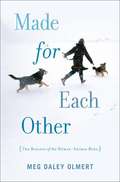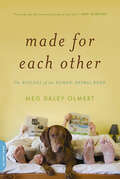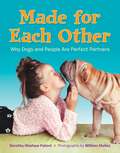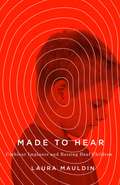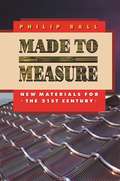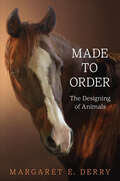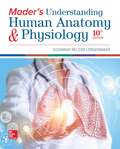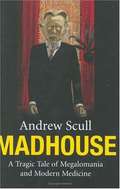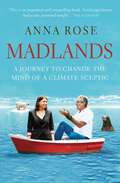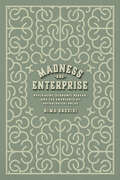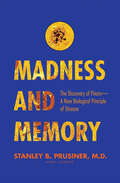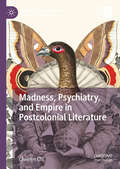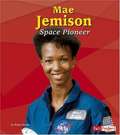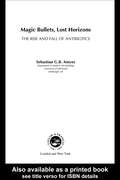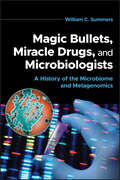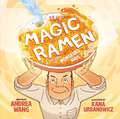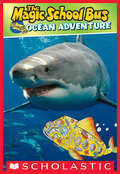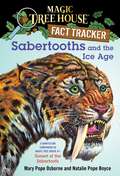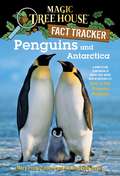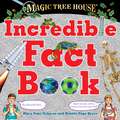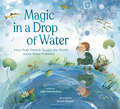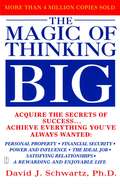- Table View
- List View
Made for Each Other: The Biology of the Human-animal Bond
by Meg Daley OlmertOxytocin is a hormone that has been implicated in romantic and maternal love. As a producer of nature documentaries for television who participated in research on the neurobiology of social bonding, Olmert examines the evidence for oxytocin as also being the basis for the evolution of the human-animal bond. Her interesting, general audience treatment concludes by noting the facilitators and barriers modern society poses for this relationship. Annotation ©2009 Book News, Inc., Portland, OR (booknews.com)
Made for Each Other: The Biology of the Human-animal Bond
by Meg Daley OlmertOxytocin is a hormone that has been implicated in romantic and maternal love. As a producer of nature documentaries for television who participated in research on the neurobiology of social bonding, Olmert examines the evidence for oxytocin as also being the basis for the evolution of the human-animal bond. Her interesting, general audience treatment concludes by noting the facilitators and barriers modern society poses for this relationship. Annotation ©2009 Book News, Inc. , Portland, OR (booknews. com)
Made for Each Other: Why Dogs and People Are Perfect Partners
by Dorothy Hinshaw Patent William MunozDog lovers everywhere will enjoy this insightful, adorable, and fact-filled photographic picture-book exploration of why dogs really are a man's best friend.It's no secret that people and pups are best friends. But did you know that this special bond dates back tens of thousands of years? During that time, we have only grown closer. Now cutting-edge science is helping us learn why we're so perfect together. Brain-imaging machines show how simply seeing you makes your dog's brain light up in its reward center. And blood samples reveal how just a touch or a gaze between two devoted friends releases helpful hormones that de-stress both pooch and person. In fact, we really speak each other's language--using pointing, barking, touch, and body movement.Dogs make our lives better in so many ways. They keep us safe, rescue us in disasters, and guide us when we can't see. But a dog's most important job is to be its person's best friend. And as we learn more about the similarities of people and our four-legged friends, it's clear we are truly made for each other."By the time you finish this book, you're ready to add a dog to your family." --Huffington Post
Made to Hear: Cochlear Implants and Raising Deaf Children (A Quadrant Book)
by Laura MauldinA mother whose child has had a cochlear implant tells Laura Mauldin why enrollment in the sign language program at her daughter&’s school is plummeting: &“The majority of parents want their kids to talk.&” Some parents, however, feel very differently, because &“curing&” deafness with cochlear implants is uncertain, difficult, and freighted with judgment about what is normal, acceptable, and right. Made to Hear sensitively and thoroughly considers the structure and culture of the systems we have built to make deaf children hear.Based on accounts of and interviews with families who adopt the cochlear implant for their deaf children, this book describes the experiences of mothers as they navigate the health care system, their interactions with the professionals who work with them, and the influence of neuroscience on the process. Though Mauldin explains the politics surrounding the issue, her focus is not on the controversy of whether to have a cochlear implant but on the long-term, multiyear undertaking of implantation. Her study provides a nuanced view of a social context in which science, technology, and medicine are trusted to vanquish disability—and in which mothers are expected to use these tools. Made to Hear reveals that implantation has the central goal of controlling the development of the deaf child&’s brain by boosting synapses for spoken language and inhibiting those for sign language, placing the politics of neuroscience front and center.Examining the consequences of cochlear implant technology for professionals and parents of deaf children, Made to Hear shows how certain neuroscientific claims about neuroplasticity, deafness, and language are deployed to encourage compliance with medical technology.
Made to Measure: New Materials for the 21st Century
by Philip BallMade to Measure introduces a general audience to one of today's most exciting areas of scientific research: materials science. Philip Ball describes how scientists are currently inventing thousands of new materials, ranging from synthetic skin, blood, and bone to substances that repair themselves and adapt to their environment, that swell and flex like muscles, that repel any ink or paint, and that capture and store the energy of the Sun. He shows how all this is being accomplished precisely because, for the first time in history, materials are being "made to measure": designed for particular applications, rather than discovered in nature or by haphazard experimentation. Now scientists literally put new materials together on the drawing board in the same way that a blueprint is specified for a house or an electronic circuit. But the designers are working not with skylights and alcoves, not with transistors and capacitors, but with molecules and atoms. This book is written in the same engaging manner as Ball's popular book on chemistry, Designing the Molecular World, and it links insights from chemistry, biology, and physics with those from engineering as it outlines the various areas in which new materials will transform our lives in the twenty-first century. The chapters provide vignettes from a broad range of selected areas of materials science and can be read as separate essays. The subjects include photonic materials, materials for information storage, smart materials, biomaterials, biomedical materials, materials for clean energy, porous materials, diamond and hard materials, new polymers, and surfaces and interfaces.
Made to Order: The Designing of Animals
by Margaret E. DerryAnimal breeding has been complicated by persisting factors across species, cultures, geography, and time. In Made to Order, Margaret E. Derry explains these factors and other breeding concerns in relation to both animals and society in North America and Europe over the past three centuries. Made to Order addresses how breeding methodology evolved, what characterized the aims of breeding, and the way structures were put in place to regulate the occupation. Illustrated by case studies on important farm animals and companion species, the book presents a synthetic overview of livestock breeding as a whole. It gives considerable emphasis to genetics and animal breeding in the post-1960 period, the relationship between environmental and improvement breeding, and regulation of breeding as seen through pedigrees. In doing so, Made to Order shows how studying the ancient human practice of animal breeding can illuminate the ways in which human thinking, theorizing, and evolving characterize our interactions with all-natural processes.
Mader's UNDERSTANDING HUMAN ANATOMY & PHYSIOLOGY
by Susannah Nelson LongenbakerRenowned for her effective learning systems, respected author Sylvia Mader has helped thousands of entry-level students understand and enjoy the principles of human anatomy and physiology. Now, Susannah Longenbaker is building on Dr. Mader's format and engaging writing style while adding her own personal touch to this successful title. The writing is still clear, direct and user-friendly, but is now enriched with new clinical information, terminology and classroom-tested features such as "Focus on Forensics" readings and in-text "Content Check-Up" questions. Drawing on over twenty years of teaching experience, Sue Longenbaker writes for the next generation of students that will learn anatomy and physiology from this classic textbook.
Mader's Understanding Human Anatomy and Physiology
by Susannah N. LongenbakerMader’s Understanding Human Anatomy and Physiology continues to be the perfect text for a one-semester course, because it was designed for this audience from the very first edition. The text is celebrating its tenth anniversary with a complete facelift, which I believe makes the content even more approachable, user friendly and exciting. Each chapter now begins with an infographic that details fascinating facts about the chapter’s subject.
Madhouse: A Tragic Tale of Megalomania and Modern Medicine
by Andrew ScullMadhouse reveals a long-suppressed medical scandal, shocking in its brutality and sobering in its implications. It shows how a leading American psychiatrist of the early twentieth century came to believe that mental illnesses were the product of chronic infections that poisoned the brain. Convinced that he had uncovered the single source of psychosis, Henry Cotton, superintendent of the Trenton State Hospital, New Jersey, launched a ruthless campaign to "eliminate the perils of pus infection." Teeth were pulled, tonsils excised, and stomachs, spleens, colons, and uteruses were all sacrificed in the assault on "focal sepsis." Many patients did not survive Cotton's surgeries; thousands more were left mangled and maimed. Cotton's work was controversial, yet none of his colleagues questioned his experimental practices. Subsequent historians and psychiatrists too have ignored the events that cast doubt on their favorite narratives of scientific and humanitarian progress. In a remarkable feat of historical detective work, Andrew Scull exposes the full, frightening story of madness among the mad-doctors. Drawing on a wealth of documents and interviews, he reconstructs in vivid detail a nightmarish, cautionary chapter in modern psychiatry when professionals failed to police themselves.
Madlands: A Journey to Change the Mind of a Climate Sceptic
by Anna RoseAn idealistic twenty-something environmentalist. A retired right-wing finance minister.All their lives, they've happily ignored each other.Until now.Anna Rose, environmental crusader since the age of fourteen and co-founder of the Australian Youth Climate Coalition, is on a mission. This is the story of her biggest challenge yet: a whirlwind journey around the world with conservative powerbroker and arch climate sceptic Nick Minchin. From a remote Hawaiian volcano to a cosmic ray laboratory in Geneva, Anna rolls out the biggest names in science to try and change Nick's mind.It's a journey to tell the story of what's happening to our climate—not just to one man, but to a nation divided on the biggest issue of our times. Nick and Anna challenge each other's views, provoking each other to confront closely held assumptions and question our responsibilities as citizens living in uncertain times.
Madness and Enterprise: Psychiatry, Economic Reason, and the Emergence of Pathological Value
by Nima BassiriUncovers a powerful relationship between pathology and money: beginning in the nineteenth century, the severity of mental illness was measured against a patient’s economic productivity. Madness and Enterprise reveals the economic norms embedded within psychiatric thinking about mental illness in the North Atlantic world. Over the course of the nineteenth century, various forms of madness were subjected to a style of psychiatric reasoning that was preoccupied with money. Psychiatrists across Western Europe and the United States attributed financial and even moral value to an array of pathological conditions, such that some mental disorders were seen as financial assets and others as economic liabilities. By turning to economic conduct and asking whether potential patients appeared capable of managing their financial affairs or even generating wealth, psychiatrists could often bypass diagnostic uncertainties about a person’s mental state. Through an exploration of the intertwined histories of psychiatry and economic thought, Nima Bassiri shows how this relationship transformed the very idea of value in the modern North Atlantic, as the most common forms of social valuation—moral value, medical value, and economic value—were rendered equivalent and interchangeable. If what was good and what was healthy were increasingly conflated with what was remunerative (and vice versa), then a conceptual space opened through which madness itself could be converted into an economic form and subsequently redeemed—and even revered.
Madness and Memory: The Discovery of Prions—A New Biological Principle of Disease
by Stanley B. PrusinerIn this &“utterly fascinating&” science memoir, the Nobel Prize–winning author chronicles his revolutionary discovery of a major cause of brain diseases (The New York Times). In 1997, Stanley B. Prusiner received the Nobel Prize in Physiology or Medicine for his research on devastating brain diseases. That he was the award&’s sole recipient was entirely appropriate. His struggle to identify the agent responsible for scrapie and mad cow disease in animals, and Creutzfeldt-Jakob disease in humans, had been waged largely alone, and in some cases, in the face of strenuous opposition. In Madness and Memory, Prusiner recounts the journey to his remarkable discovery of prions—infectious proteins that replicate and cause disease, but surprisingly contain no genetic material. Along the way, he sheds light on the world of contemporary science and the meticulousness and perseverance it requires. Through his telling, the agony and triumph of years of research comes to life, along with fascinating portraits of fellow scientists racing to make breakthrough discoveries. Prusiner&’s hypothesis, once considered heresy, now stands as accepted science and provides a path toward conquering such pervasive scourges as Alzheimer&’s, Parkinson&’s, Lou Gehrig&’s, and others diseases. &“Madness and Memory is the story of one of the most important discoveries in recent medical history, and it is also a vivid and compelling portrait of a life in science.&” —Oliver Sacks, MD, neurologist and author of Hallucinations
Madness, Psychiatry, and Empire in Postcolonial Literature (Palgrave Studies in Literature, Science and Medicine)
by Chienyn ChiMadness, Psychiatry, and Empire in Postcolonial Literature provides a comparatist interrogation of empire through archives of history, science, and literature. The book analyzes Aimé Césaire’s Discourse on Colonialism to shed light on Césaire’s critique of psychological and medical discourses of the colonized’s mind. The book argues that the discourse of psychiatry, psychology, and psychoanalysis has erased the context of power in global histories of empire. Through the book’s chapters, Chi analyzes Lu Xun’s “A Madman’s Diary,” Virginia Woolf’s Mrs. Dalloway, and Tsitsi Dangarembga’s Nervous Conditions to assert that the misapprehension of madness should not automatically be accepted as the history of an isolated Western culture but rather that of the history of imperialism—a globalizing process that silences alternative cultural conceptions of the mind, of madness, and of behavior, as well as different interpretations of madness.
Mae Jemison: Space Pioneer (Fact Finders Biographies: Great African Americans)
by Robert Kraske James GerardProvides an introduction to the life and biography of Mae Jemison, the first African-American woman to travel into space in 1992 on the space shuttle Endeavour.
Magdalene's Ascension: Mary's Journey to Becoming Light
by Annine van der Meer• Examines the lives of Jesus and Mary Magdalene, using biblical, historical, apocryphal, and recent channeled sources as well as regression reports• Explains the concept of ascension through a quantum-physics framework, detailing Mary Magdalene&’s ascension along the Tree of Life• Explores Mary&’s family background, her education in Egypt, her mission in Western Europe, and her life and work alongside Jesus, including her role as his wife and his appointed successorExpanding the scholarship and understanding of the early Christian period and the world of the Essenes from a feminine perspective, religious historian Annine van der Meer offers a detailed new account of the life of Mary Magdalene, also known as Mary of Bethany or Miryam the Migdalah, showing how Mary&’s spiritual path is intimately connected to our current times of ascension.The author explores Mary&’s family background, her education in Egypt, her mission in Western Europe, her life and work alongside Jesus, also known as Yeshua, and her anointing as his wife and his appointed successor. Though not recognized by the patriarchal disciples Peter, Andrew, and Paul, the author presents the evidence of Mary&’s role through biblical, historical, apocryphal, and recent channeled sources and regression reports, including those of Dolores Cannon, Stuart Wilson, Joanna Prentis, and Claire Heartsong.Van der Meer then reveals Mary&’s ascension process through seven branches along the Tree of Life, detailed in The Gospel of the Beloved Companion, written by Mary herself, and scientifically explains ascension—the changing of the physical body into a light body—through recent developments in quantum physics. She takes the reader through seven portals, from individual ascension to collective ascension, illuminating not only Mary&’s heavenly journey of becoming light but also its spiritual significance for each of us as individuals and for the world as a whole.
Magic Bullets, Lost Horizons: The Rise and Fall of Antibiotics
by Sebastian G. AmyesFrom the day that Paul Ehrlich hailed his newly discovered treatment for syphilis as the magic bullet, antibiotics have transformed medical practice. They are considered one of the miracle drugs of the 20th century. However, the massive and increasing misuse of these agents is More...causing a problem of resistance that may prove to be one of the greatest threats to health in the 21st century. Magic Bullets, Lost Horizons aims to put some of the media sensationalism into perspective. It examines not only the development of modern antibiotics but also the obstacles faced during application of the drugs and their expected efficacy in the future.
Magic Bullets, Miracle Drugs, and Microbiologists: A History of the Microbiome and Metagenomics
by William C. SummersMagic Bullets, Miracle Drugs, and Microbiologists Magic Bullets, Miracle Drugs, and Microbiologists: A History of the Microbiome and Metagenomics by William C. Summers is an enlightening journey through the fascinating world of microbiology, exploring its history, challenges, and the revolutionary concept of the microbiome. Summers draws from his unique perspective as both a practicing microbiologist and a historian of science, influenced by early microbiological literature and his own extensive career, presenting how our understanding of microbes evolved from concepts of simple germs to complex, essential elements of life. Summers skillfully ties together key players and eras in the microbial sciences into a concise narrative, from early microscopic observations to the revolutionary developments in genetic analysis and metagenomics, highlighting our ever-evolving understanding of the diverse microbial world. Magic Bullets, Miracle Drugs, and Microbiologists is a compelling read for anyone interested in the profound impact of microorganisms on our world. “Bill Summers artfully explains how, over the past century, scientists have synthesized new disciplines and embraced evolving technologies to develop new concepts about how germs behave in microbial communities and what their relationship is to the environment, human health, and epidemic diseases. Skillfully written in engaging prose, this book will be valuable to microbiologists, epidemiologists, medical historians, and geneticists seeking to better understand the historic roots of twenty-first century microbiology.” — Powel H Kazanjian, University of Michigan Medical School and Author of Frederick Novy and the Development of Bacteriology in Medicine
Magic Ramen: The Story of Momofuku Ando
by Andrea WangWorld War II was over, but in Japan, lines for a simple bowl of ramen noodles wound down the sidewalk. What Momofuku Ando did next would change food forever. Andrea Wang, author of Watercress (a Newberry honor book and winner of the Caldecott Medal), tells the true story behind the creation of one of the world's most popular foods."An inspiring story of persistence and an ideal purchase for any collection." School Library Journal, STARRED review2021 Nutmeg Book Awards NomineeWinner of the 2020 Sakura AwardRead Across America Book of the Month, May 2021Center for Multicultural Children's Literature Best Book of 2019 ListSmithsonian Magazine '10 Best Children's Books of 2019′ ListEvery day, Momofuku Ando would retire to his lab--a little shed in his backyard. For years, he'd dreamed about making a new kind of ramen noodle soup that was quick, convenient, and tasty for the hungry people he'd seen in line for a bowl on the black market following World War II. Peace follows from a full stomach, he believed.Day after day, Ando experimented. Night after night, he failed. But Ando kept experimenting.With persistence, creativity, and a little inspiration, Ando succeeded. This is the true story behind one of the world's most popular foods.
Magic School Bus: Ocean Adventure (Scholastic Reader, Level 2)
by Mary Kay CarsonNow early readers can take a ride on the Magic School Bus!With the help of Ms. Frizzle, young readers can develop their reading skills while they pick up fun facts about the world's ocean. Ms. Frizzle's class will teach you everything you ever wanted to know about the deep sea through this engaging and accesible reader. This is a great introduction to the Magic School Bus program.
Magic Tree House Fact Tracker #12: Sabertooths and the Ice Age
by Mary Pope Osborne Sal Murdocca Natalie Pope BoyceMagic Tree House Research Guides are now Magic Tree House Fact Trackers! Track the facts with Jack and Annie! When Jack and Annie got back from their adventure in Magic Tree House #7: Sunset of the Sabertooth, they had lots of questions. What was it like to live in the Ice Age? How did early humans stay warm enough to survive? Who made the first cave paintings? What happened to saber-toothed cats and woolly mammoths? Find out the answers to these questions and more as Jack and Annie track the facts. Filled with up-to-date information, photos, illustrations, and fun tidbits from Jack and Annie, the Magic Tree House Fact Trackers are the perfect way for kids to find out more about the topics they discovered in their favorite Magic Tree House adventures.
Magic Tree House Fact Tracker #18: Penguins and Antarctica
by Mary Pope Osborne Sal Murdocca Natalie Pope BoyceMagic Tree House Research Guides are now Magic Tree House Fact Trackers! Track the facts with Jack and Annie! When Jack and Annie got back from their adventure in Magic Tree House #40: Eve of the Emperor Penguin, they had lots of questions. What do penguins eat? Why do they huddle together in groups? Who won the race to the South Pole? What happens at a research station in Antarctica? Find out the answers to these questions and more as Jack and Annie track the facts. Filled with up-to-date information, photos, illustrations, and fun tidbits from Jack and Annie, the Magic Tree House Fact Trackers are the perfect way for kids to find out more about the topics they discovered in their favorite Magic Tree House adventures.
Magic Tree House Incredible Fact Book: Our Favorite Facts about Animals, Nature, History, and More Cool Stuff! (Magic Tree House (R))
by Mary Pope Osborne Natalie Pope BoyceJack and Annie&’s biggest, most exciting book of facts is their greatest adventure outside the tree house! Jack and Annie have been all over the world in their adventures in the magic tree house. And they&’ve learned lots of incredible facts along the way. Now they want to share them with you! Get ready for a collection of the coolest, weirdest, funniest, grossest, most all-around amazing facts Jack and Annie have ever encountered. With full-color photographs and fun comments from Jack and Annie, this is the essential fact book for all Magic Tree House fans.
Magic in a Drop of Water: How Ruth Patrick Taught the World about Water Pollution
by Julie WinterbottomAn entertaining and gorgeous picture book biography of scientist and environmental hero Ruth Patrick, one of the first to warn about the dangers of pollution.A brilliant scientist and intrepid explorer, the ecologist Ruth Patrick taught the world how to care for the environment. She studied water pollution long before it became a public concern and gave other scientists the tools to do something about it. Born in 1907, Ruth Patrick was one of the only women in her field when she made her breakthrough discovery about biodiversity and the ecosystem of rivers, forever changing how ecologists understand pollution.Lyrically, joyfully written, exquisitely illustrated, and full of fascinating details and a rich afterword and timeline, this STEM biography will inspire readers who love the environment to follow their passion and curiosity.
Magic of Thinking Big
by David SchwartzMillions of people throughout the world have improved their lives using The Magic of Thinking Big. Dr. David J. Schwartz, long regarded as one of the foremost experts on motivation, will help you sell better, manage better, earn more money, and -- most important of all -- find greater happiness and peace of mind. The Magic of Thinking Big gives you useful methods, not empty promises. Dr. Schwartz presents a carefully designed program for getting the most out of your job, your marriage and family life, and your community. He proves that you don't need to be an intellectual or have innate talent to attain great success and satisfaction -- but you do need to learn and understand the habit of thinking and behaving in ways that will get you there. This book gives you those secrets!
